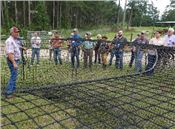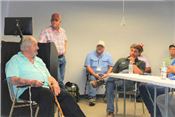Feral Hogs, Black Flies, Topics Of AgCenter-Hosted Meeting
JOHNNY MORGAN
CLINTON, LOUISIANA
The LSU AgCenter Bob R. Jones-Idlewild Research Station recently hosted members of the National Association of Conservation Districts and the Louisiana Department of Agriculture and Forestry.
The group spent part of their three-day Baton Rouge conference hearing about the research being done at the station.
In addition to work to help decrease the feral hog population in the state, the researchers also are focusing on the damage that black flies are causing in the state turkey population.
LSU AgCenter researcher Ariel Bourgoyne said the state’s wild turkey population has been in decline in recent years, and it is believed that black flies could be the culprit.
“In addition to getting into their eyes, nose and throat, there is protozoa connected to the flies that could also be blamed for the decline,” she said.
Bourgoyne is using 2-day-old domestic turkeys for her study of the protozoa, which are microscopic organisms. She said she would have liked to use wild turkeys, but that didn’t seem like a good idea because their numbers are already in decline.
“We raise them up to a month old, then I put them outside for two weeks,” she said. “Then I let them quarantine for two weeks.”
At that point, they are dispatched, and samples from the spleen, liver and blood are taken to see if they contracted the protozoa, she said.
These flies are also responsible for the transmission of viruses in deer, cattle and other animals.
AgCenter entomologist Lane Foil said that 2012 was the year of a major epizootic hemorrhagic disease (EHD) and bluetongue virus outbreak in Louisiana.
EHD is the most common infectious disease of white-tailed deer, with outbreaks occurring almost every year in the Southeast. The disease is caused by either of two closely related viruses: EHD virus or bluetongue virus, said Jim LaCour, state wildlife veterinarian with the Louisiana Department of Wildlife and Fisheries.
A widespread outbreak of hemorrhagic disease is called an epizootic, which is the term applied to animals – equivalent to epidemic in people. Survivors of the disease have immunity, but maybe not for life, Foil said. In some years, the epizootics in Louisiana are more dramatic than in other years he said.
“Research has shown that cattle that survived the 2010 Texas drought were sold in Louisiana, and their tags were traced back to areas where the diseases were prevalent,” he said.
Another cause of the outbreak goes back to Hurricane Isaac and its consequent flooding, which increased deer density in the areas unaffected by high water.
These large concentrations of animals are more likely to be infected because midges find them easier, Foil said.
Foil has been conducting research on the disease at the Wildlife Research Institute at the Idlewild station in Clinton. The station provides a unique opportunity to study the disease because it has captive herds of white-tailed deer and red deer along with cattle and wild deer on the 1,800-acre facility.
Foil said the virus must reproduce in the midge before it can be transmitted to another animal.
“The insect bites infected animals and takes in the virus, which replicates in the midge, a process which can take about a week,” Foil said. “Then the midge bites another animal and transmits the virus.”
Hemorrhagic disease is of particular concern for managed deer farms, of which Louisiana has between 200 and 400.
The results of Foil’s research can help them maintain and improve their operations, which he says is important because managed, captive deer herds are economically critical.
Bourgoyne said so far none of her turkeys have contracted the disease associated with the protozoa.
“These findings are bittersweet,” she said. But her plan is to keep going and move to different locations to continue research.
Glen Gentry, coordinator of the research station, gave an update on the research that he is conducting on the development of lethal bait for wild pigs.
He said there is no way to shoot or trap enough pigs to significantly reduce their populations. The work he is doing with encapsulated sodium nitrite is showing promise.
“Research has shown that poison is 11 times cheaper than shooting and 80 times cheaper than trapping if you include all the time and effort involved,” he said.
Gentry told of the feral hog eradication efforts on Santiago Island off South America.
“They used hunting, trapping, snares and poison to get rid of 18,000 pigs,” he said. “It took them 30 years to get rid of them.”
Theron Phillips, of the Louisiana Department of Agriculture and Forestry Office of Water Conservation, said there are 44 conservation districts funded by LDAF in the state.
“The primary purpose is water conservation,” he said. “Their meetings are open to the public, and they are allowed to address their resource concerns. Natchitoches was the first parish to start their own abatement program.”
Phillips said there are nine conservation district employees who are full-time feral swine trappers.
Ten parishes in the state are currently apart of the 10-state, three- year pilot program.
“This is the third year of the program, and it is hoped that it will be re-funded,” Phillips said.
Trey Land, executive director of the Oklahoma Conservation Commission, explained how each state operates a little differently depending on the conservation needs.
“In Oklahoma, we have the USDA Natural Resources Conservation Service, our state agency and, on the local level, we have 84 conservation districts,” he said. “Our state agency helps coordinate those conservation districts, and we also take care of 2,107 flood control dams.”
Land said Oklahoma also has a feral hog eradication program along with other conservation projects that help farmers and ranchers.
The National Association of Conservation Districts meeting rotates among four states and will be held in Texas next year, with Oklahoma
hosting in 2024. ∆
JOHNNY MORGAN: LSU AGCenter

Glen Gentry, coordinator of the LSU AgCenter Bob R. Jones-Idlewild Research Station, explains how various hog traps work to members of the National Association of Conservation Districts and the Louisiana Department of Agriculture and Forestry during a recent meeting at the station.
Photos by Johnny Morgan/LSU AgCenter

LSU AgCenter entomologist Lane Foil, seated, discusses his research on black flies to members of the National Association of Conservation Districts and the Louisiana Department of Agriculture and Forestry during a recent meeting at the LSU AgCenter Bob R. Jones-Idlewild Research Station in Clinton. Black flies are a vector for major epizootic hemorrhagic disease (EHD) and bluetongue virus in Louisiana. He’s also looking at its influence on the decline in the wild turkey population.